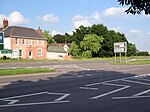Claybrooke Parva
Civil parishes in Harborough DistrictLeicestershire geography stubsUse British English from July 2015Villages in Leicestershire

Claybrooke Parva is a village and civil parish in the Harborough district south west Leicestershire, England close to Claybrooke Magna. The village is the site of a church which is thought to originally be part Anglo Saxon with Norman and Medieval additions. The population of the civil parish at the 2011 census was 208.The village's name means 'brook with clayey soil'.
Excerpt from the Wikipedia article Claybrooke Parva (License: CC BY-SA 3.0, Authors, Images).Claybrooke Parva
Harborough Claybrooke Parva
Geographical coordinates (GPS) Address Nearby Places Show on map
Geographical coordinates (GPS)
| Latitude | Longitude |
|---|---|
| N 52.483333333333 ° | E -1.2666666666667 ° |
Address
LE17 5AD Harborough, Claybrooke Parva
England, United Kingdom
Open on Google Maps









